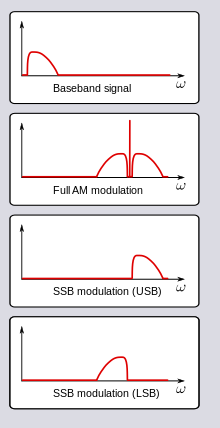
Back تضمين أحادي الجانب Arabic Banda lateral única Catalan Enkelt-sidebåndsmodulation Danish Einseitenbandmodulation German Modulación de banda lateral única Spanish مدولاسیون باندکناری-تک Persian SSB Finnish Bande latérale unique French Egy oldalsávos moduláció Hungarian Modulazione a banda laterale singola Italian
This article needs additional citations for verification. (July 2015) |

| Passband modulation |
|---|
 |
| Analog modulation |
| Digital modulation |
| Hierarchical modulation |
| Spread spectrum |
| See also |
In radio communications, single-sideband modulation (SSB) or single-sideband suppressed-carrier modulation (SSB-SC) is a type of modulation used to transmit information, such as an audio signal, by radio waves. A refinement of amplitude modulation, it uses transmitter power and bandwidth more efficiently. Amplitude modulation produces an output signal the bandwidth of which is twice the maximum frequency of the original baseband signal. Single-sideband modulation avoids this bandwidth increase, and the power wasted on a carrier, at the cost of increased device complexity and more difficult tuning at the receiver.
© MMXXIII Rich X Search. We shall prevail. All rights reserved. Rich X Search